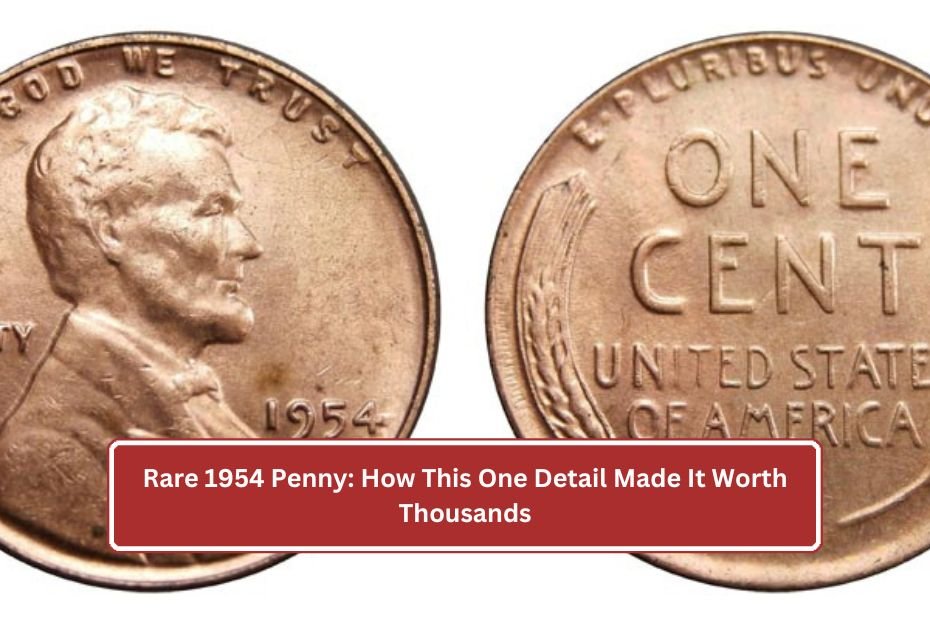Some Lincoln pennies may be worth thousands of dollars thanks to one small but significant detail. Recently, experts explained that a 1954 penny with a rare feature sold for over $9,000 due to its condition and rarity. Let’s break down what to look for, how to identify rare pennies, and what makes certain coins so valuable.
Unique Features of the Rare 1954 Penny
The main reason this 1954 Lincoln penny is so valuable lies in its condition and minting location:
- No Mint Mark: This particular coin was made at the Philadelphia Mint, which means it has no mint mark on its front side. Coins made here without a mint mark are rare, especially in high-grade conditions.
- Grade of MS-67 Red: The coin’s Mint State 67 (MS-67) Red grading means it has about 95% of its original red color, which significantly boosts its appeal and value. Coins in this grade are hard to find in excellent condition and are especially attractive to collectors.
The penny sold for over $9,000 due to these factors. Only about 20 similar coins are believed to exist, which makes this penny rare and valuable.
Coin Grading and Why It Matters
To understand a coin’s value, it helps to know how coin grading works. Coins are graded on a scale from 1 to 70 based on their condition, with Mint State (MS) 60 and above considered some of the best:
| Coin Grade | Description | Condition Significance |
|---|---|---|
| MS-67 | Excellent, 95% original red color | High appeal and rarity |
| MS-60 | Good, no signs of wear | Still valuable but less rare |
| Below 60 | Shows visible wear or discoloration | Value usually lower |
Higher-grade coins, especially in MS-67 and above, are highly desirable due to their pristine condition and rarity.
More Coins to Watch: Valuable Pennies and Nickels
In addition to the 1954 penny, other coins with unique features have been found to be worth thousands:
- 2009 Penny: Some 2009 pennies weigh more than the usual 2.5 grams due to a higher copper content (95%). These pennies, commemorating Abraham Lincoln’s life, were part of a special collection, making them more valuable than typical pennies.
- Indian Head Pennies: Older coins, such as the Indian Head pennies, can be extremely valuable if in excellent condition or with a rare mint mark.
Here’s a quick reference guide to some valuable coins and their key features:
| Coin Type | Key Feature | Potential Value |
|---|---|---|
| 1954 Lincoln Penny | No mint mark, MS-67 grade | Up to $10,000+ |
| 2009 Lincoln Penny | Special strike, 95% copper | Around $7,500 |
| Indian Head Penny | Rare mint mark, high grade | Tens of thousands |
Getting Into Coin Collecting
For beginners interested in coin collecting, Steve Feltner, a numismatic expert at the Professional Coin Grading Service (PCGS), offers helpful advice:
- Follow Your Interests: Choose coins that appeal to you, whether it’s due to their design, historical period, or another personal connection.
- Use Reference Guides: The Red Book is a valuable annual publication that helps collectors learn about valuable coins and what details to look for.
- Consider Global Coins: Many U.S. coins have already been discovered, so expanding to global coins can open up more opportunities.
Final Thoughts on Collecting Rare Coins
Coin collecting offers more than just financial value; it connects people to history and rare finds. From the 1954 Lincoln penny with its unique features to modern coins with unusual minting details, these coins hold stories and can be worth thousands. For collectors, the key to finding valuable coins often lies in details like mint marks, weight, and grade. So, check your spare change—you might have a treasure waiting!
FAQ’s
What makes a 1954 Lincoln penny worth so much money?
A 1954 Lincoln penny can be valuable if it was minted in Philadelphia (no mint mark) and has a high grade, like MS-67 Red. These pennies, especially in excellent condition, are rare and can sell for over $9,000.
How do I know if my penny is valuable?
To check if your penny is valuable, look for key features like unusual weight, specific mint marks, and high-grade conditions. A grading service, like PCGS, can help confirm a coin’s grade and rarity.
What is the best way to start coin collecting?
Start by choosing coins that interest you, like specific designs or historical periods. Reference guides, such as the annual “Red Book,” are also helpful for learning which coins are rare and valuable.

